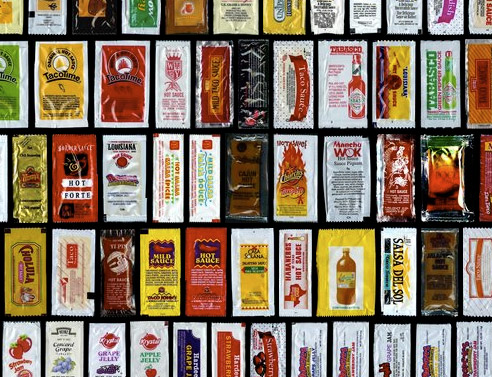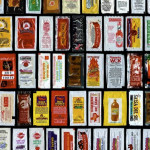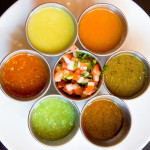This will turn into a small rant about which very few people will agree, but what the hell. The joy of running your own website and being your own editor is that you can say what you want regardless!
Condiments have become hugely big business. I guess they were always there as a means of adding flavour and variation to tart up food that might otherwise be dull and flavourless. But what are they? Cue Wikipedia’s definition, including American spellings!
A condiment is an edible substance, (such as a simple sauce) which is used to be added to some foods to impart a particular flavor, enhance its flavor, or in some cultures, to complement the dish. The term originally described pickled or preserved foods, but has shifted meaning over time. Many condiments are available packaged in single-serving sachets (packets), like mustard or ketchup, particularly when supplied with take-out or fast-food meals. Condiments are usually applied by the diner. Condiments are sometimes added prior to serving, for example a sandwich made with ketchup or mustard. Some condiments are used during cooking to add flavor or texture to the food; barbecue sauce, teriyaki sauce, soy sauce, marmite are examples, as are:
If it were simply a matter of choice and individuality I doubt if anyone would disagree with the practice of serving any given meal with dips or sauces. Witness Danny Baker’s Five Live radio show, the home of the sausage sandwich game, in which callers playing the game are required to guess whether a celebrity (usually a footballer) would choose to anoint his sausage sandwich with red sauce, brown sauce, or no sauce at all. Statistically, over 50% go for brown though I suspect there are some difficult ones who would sooner choose mustard or Branston pickle, to name but two. But you get the idea – there is a strong and growing culture of applying condiments, and a vast industry happy to manufacture these and sell us ever-growing variants to tune our food to our individual taste – even if that means every meal ends up tasting alike due to our condiment habits.
It’s not just this country, of course, but everywhere you look there are condiments designed to enhance our dining experience. Go to an Indian restaurant and you begin with poppadums and a tray of condiments, usually including a mint sauce, sweet mango chutney, onion with tomato, and lime pickle. There may be other variants but we do love the process of applying these substances. Sometimes you wonder if chips are merely a vehicle for scooping up sweet tomato ketchup into our mouths. Can you imagine eating fish and chips without adorning it with salt and vinegar, lamb without mint sauce, pork without apple, beef without horseradish… Whatever the occasion and whatever the snack, there is a condiment, flavouring or relish to match the dish, be it a sauce, pickle, chutney, marinade, dressing, mayo or accompaniment. And naturally, the industry caters for our tastes with abandon. Supermarket shelves are stacked high with inventive products to accompany our dishes.
However, we seem to have become a nation of condiment junkies – or should that be zombies? We douse our grub with our preferred condiments automatically, without tasting. The one area where you would hope people would draw the line is where someone has spent hours cooked a delectable and perfectly seasoned dinner, only for the diner to swathe it in a thick layer of salt, giving the appearance of a snow-covered Christmas card. Why do some people do that? Is it anticipation that food will have no flavour? Nope, simply habit, and not a good one!
So beef number one is that we are using condiments so blindly and blandly we lose sight of the food. But that is not my only beef! Picture the scene: you’re in your works canteen, or a motorway service station restaurant, or a cafe, or wherever it happens to be, ordering breakfast. You ask for some tomato ketchup to accompany the meal, but rather than getting a bottle from which to take as much or little as you need they give you small sachets, and then rub salt into the wound by charging you 10p or more a go. To be fair, McDonalds and other fast food joints have stopped doing this and instead have a squeezy contraption and tiny pots you can take to the table for ketchup or BBQ sauce, but it is very common practice elsewhere.
Problem number two comes when you sit down and decide to open these fiendishly awkward little containers. They look simple enough but when you actually get to open them many resist with unsurpassed defiance every attempt to rip the packaging down the arrowed slit. If you succeed the contents will leap out and drape themselves fetchingly down your shirt, thus disproving the myth that they are much less messy than full bottles. Anyway, once you have returned from the toilet to remove said sauce from your clothing, your breakfast may well be cold and you could well have lost the will to live, but you make one more effort and finally get the little buggers to open… only to realise that one contains nothing like enough and that you needed three to get the right quantity of sauce, so the whole process starts again. Ah, but the technology has moved on – you can now get sauces in tiny squeezable bottles that are relatively easy to open and contain more sauce, though they in turn cost more.
The principle is the same with those irritating pats of butter and almost any product now made in tiny packs. From the point of view of the restaurant, they are often shaving down costs to fractions of a penny, and having whole bottles of tomato sauce costs them money (and they would argue it is unhygienic, though I doubt there is much in it.) Give a consumer a sauce bottle and they will spray it over their food and frequently waste it. Portion control means they can charge or not, but either way they can control how much the customer takes.
On the other hand, packaging tiny quantities costs money and ultimately spells more profit for the food industry that provides these nasty little devices, without actually making life any better at all for the person who really matters, the customer.
Then again, we should really be focusing on the quality of the food and not the condiments. Better still, in the ideal world the condiments should be home-made too, so their quality matches the home-cooked food we should endeavour to serve. Time was when my mother and many other housewives busily spent their summers taking cheap seasonal ingredients and preserved them for the months ahead, in the form of pickling (onions, gherkins, red cabbage etc.), chutneys (her piccalilli was especially good), jams, jellies, sauces, every manner of wonderful accompaniment. How often do people do that nowadays?
Ah, for the inventiveness of yesteryear… which reminds me of a story my dad used to tell. Before he married my mum, he had dinner at her family home in the days when HP sauce bottles had corks rather than screw tops. He shook the bottle rather too vigorously, whereupon the cork flew out and the sauce ended up on the ceiling. It’s a wonder he ended up marrying my mum at all!





This year i made autumn chutney and often make chilli jam and onion marmalade, neitther of the kids will eat it though it has to be ketchup or bbq – far too sweet for my liking………..i very rarely touch processed condiments tho i do confess to having the need for a touch of brown on a bacon sandwich lol!
My son John successfully managed to cover himself and half the dining room in ketchup when the lid hadnt been put on right and he shook the bottle………one of those moments you really wish you had a comera lol!
Good for you, though you are decidedly in the minority these days. Kids never learn the techniques if parents never preserve fruit and veg.